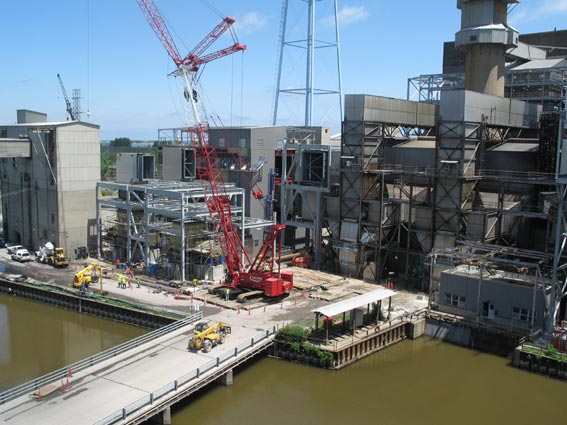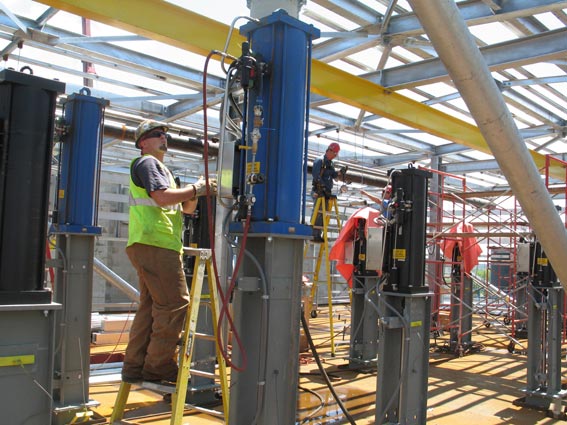New Karn plant vacuum system will better clean its emissions
Date Posted: June 25 2010
HAMPTON TWP. – Consumers Energy’s Karn-Weadock Generating Complex – which has employed thousands of building trades workers performing various projects over the past few decades – is playing the host again.
Work began last October on the $189 million “Pulse Jet Fabric Filter Project,” a task that will result in the construction of two new pollution control systems at the plant’s coal-fired Karn Units 1 and 2. Related to the project are extensive duct and electrical work and other tie-in tasks.
The project is currently employing some 225 construction workers, and is at peak employment. Both Units 1 and 2 will remain in operation until the wrap-up of the work, which is expected to take place in the first quarter of 2011.
The Karn-Weadock plant has been extensively modified over the years since the first coal-burning boilers came on line in 1959-1960, and introducing modern pollution controls and more efficient fixtures into the old plant has always been a design challenge.
“You can see that we’re in a tight space, and everybody is working on top of each other,” said Consumers Energy Construction Manager Scott McCulloch. “There’s not a lot of room to move around, but the people out here are doing a really good, safe job.”
The footprint of the containment structures for both Units 1 and 2 on the Pulse Jet Fabric Filter Project are both confined by a canal that runs through the property and whose water provides cooling for the plant.
According to Consumers Energy’s Point-of-Contact Engineer Jerome DeCarlo, the new fabric filter system will remove particulate matter from the boiler’s flue stream.
The new system will use vacuum bag filters in each unit to catch the fly ash, in a set-up akin to a home vacuum cleaner. But the bags that will go into this system are a little bigger than what’s in your average Hoover upright – they’re 30 feet long by 8 inches in diameter, and there will be 1,080 of them in each unit.
The system will blow the fly ash off the bags, and collect it in hoppers. The bags have an estimated life of five years.
DeCarlo said this is the first Consumers Energy plant that will receive the fabric filter upgrade, and the utility is following a path of “maximum achievable control technology” for the removal of sulfur dioxide and mercury from the plant’s emissions. He said the system has become a proven technology in other plants around the country. “The biggest challenge here has been finding a place to put them,” he said.
Worley Parsons is acting as construction manager of the project, and leading the project for them is Lebron Creech. Early on, he said, planning had to include a careful investigative process, looking over old plans for any underground utilities or other hazards that needed to be avoided.
“The old drawings were pretty good, but over the years things sometimes get buried that you don’t know about,” Creech said. He added, “the people here are doing very well, and the tripartite (labor-owner-contractors) meetings we have every month have been very helpful.” The cooperation is certainly a benefit to safety at the site: as of June 9, 289,000 man-hours had been worked on the project without a recordable safety incident.
Our visit to the ongoing construction at Karn 1 & 2 occurred two weeks after Consumers Energy announced the indefinite deferral of construction of a new $1.2 billion clean-coal power plant at the Karn-Weadock site. John Russell, the president and chief executive officer of CMS Energy and Consumers Energy, said “the current timetable for the new unit isn’t consistent with today’s market conditions.”
However, Russell said “a number of alternative investment options, including additional environmental controls on some of our existing coal-fired units…will support our efforts to provide customers with reliable and affordable energy.” He added that those investments are expected to create nearly the same number of jobs as the clean coal plant.
The Karn/Weadock Generating Complex is Consumers Energy’s largest power production complex and consists of three separate plants: the 310-megawatt coal-fueled Weadock plant; the 515-megawatt coal-fueled Karn 1 & 2 plant; and the 1,276-megawatt natural gas- and oil-fueled Karn 3 & 4 plant. Together, Karn/Weadock and associated combustion turbines can generate up to 2101 megawatts, enough to meet the electric needs of Bay City, Saginaw, Midland and Flint combined.

CONSUMERS ENERGY’S Pulse Jet Fabric Filter Project is being erected adjacent to Karn Unit 1 at the Karn-Weadock Generating Complex near Bay City. A similar pollution control system is being built across the canal at the Karn Unit 2.

WORKING ON an actuator pop-up valve atop the Unit 2 Pulse Jet Fabric Filter Project at the Karn Weadock Plant is Matt Bleicher of Boilermakers Local 169, working for Boldt.
